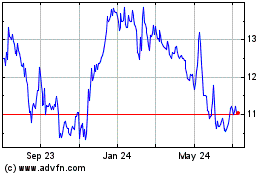UNITED STATES
SECURITIES AND EXCHANGE COMMISSION
Washington, D.C. 20549
Form 6-K
Report of Foreign Private Issuer
Pursuant to Rules 13a-16 or 15d-16 under
the Securities Exchange Act of 1934
For the month of January 2024
Commission File Number: 001-38836
BIOCERES CROP
SOLUTIONS CORP.
(Translation of registrant’s name into English)
Ocampo 210 bis, Predio CCT, Rosario
Province of Santa Fe, Argentina
(Address of principal executive offices)
Indicate by check mark whether the registrant files or will file annual
reports under cover Form 20-F or Form 40-F.
Form 20-F x
Form 40-F ¨
Indicate by check mark if the registrant
is submitting the Form 6-K in paper as permitted by Regulation S-T Rule 101(b)(1): ¨
Indicate by check mark if the registrant
is submitting the Form 6-K in paper as permitted by Regulation S-T Rule 101(b)(7): ¨
EXPLANATORY NOTE
Exhibit List
SIGNATURES
Pursuant to the requirements of the Securities Exchange Act of 1934,
the registrant has duly caused this report to be signed on its behalf by the undersigned, thereunto duly authorized.
| |
BIOCERES CROP SOLUTIONS CORP. |
| |
(Registrant) |
| |
|
|
| |
|
|
| Dated: January 24, 2024 |
By: |
/s/ Federico Trucco |
| |
Name: |
Federico Trucco |
| |
Title: |
Chief Executive Officer |
Exhibit 99.1
Bioceres Crop Solutions Releases
Scope 1 & 2 Greenhouse Gas Emissions Report
ROSARIO, Argentina—January 23,
2024 (BUSINESS WIRE) —Bioceres Crop Solutions Corp. (NASDAQ: BIOX), a leader in the development and commercialization of productivity
solutions designed to regenerate agricultural ecosystems while making crops more resilient to climate change, announced today the release
of the company’s global greenhouse gas emissions report.
The report takes inventory of the company´s
fiscal year 2023 Scope 1 &2 greenhouse gas emissions across all operations, spanning manufacturing plants, research and development
campuses, and administrative offices in Argentina, Brazil, Estonia, and the United States. The calculations were undertaken by an independent
third-party expert, Boundless Impact Research and Analytics, and follow GHG Protocol guidance established by the World Resources Institute
and the World Business Council for Sustainable Development.
Since the FY21
baseline, the company has undertaken significant initiatives to reduce its global greenhouse gas emissions, primarily via transitioning
operations to zero-emission renewable energy sources where available, investing in more energy-efficient utilities, machinery and vehicles—particularly
with new construction and during facility upgrades, introducing monitoring equipment and software that provides real-time feedback on
resource consumption and utilization, and pursuing net zero-waste certification for its operations.
During FY23, activities within Bioceres resulted
in a total of 8,187 metric tons of CO2e, of which 66% are a result of Scope 1 emissions and 34% are a result of Scope 2 emissions. Bioceres
achieved a 33.7% reduction in global Scope 2 emissions compared to the baseline year by transitioning the Davis, California campus and
Bangor, Michigan plant to zero-emission, all-renewable energy sources. The company plans to transition three facilities in the Pergamino,
Argentina campus, starting mid-calendar year 2024 with the expectation of replacing 40% of total electrical usage in those facilities.
“As an organization,
our focus is to reduce emissions in agriculture through the adoption of our products. This starts with the monitoring and minimization
of emissions in our own operations. We have taken important steps in the past two years to reduce our own footprint and improve our sustainability
and energy efficiency efforts and will continue to do so as we expand our commercial activities globally” said Federico
Trucco, Chief Executive Officer.
About Bioceres Crop Solutions
Corp.
Bioceres Crop Solutions Corp.
(NASDAQ: BIOX) is a leader in the development and commercialization of productivity solutions designed to regenerate agricultural ecosystems
while making crops more resilient to climate change. To do this, Bioceres’ solutions create economic incentives for farmers and
other stakeholders to adopt environmentally friendlier production practices. The Company has a unique biotech platform with high-impact,
patented technologies for seeds and microbial ag-inputs, as well as next generation crop nutrition and protection solutions. Through
its HB4 program, the Company is bringing digital solutions to support growers’ decisions and provide end-to-end traceability for
production outputs.
Forward-looking statements
This communication includes “forward-looking
statements” within the meaning of the “safe harbor” provisions of the United States Private Securities Litigation Reform
Act of 1995. Forward-looking statements may be identified by the use of words such as “forecast,” “intend,” “seek,”
“target,” “anticipate,” “believe,” “expect,” “estimate,” “plan,”
“outlook,” and “project” and other similar expressions that predict or indicate future events or trends or that
are not statements of historical matters. Such forward-looking statements are based on management’s reasonable current assumptions,
expectations, plans and forecasts regarding the Company’s current or future results and future business and economic conditions
more generally. Such forward-looking statements involve risks, uncertainties and other factors, which may cause the actual results, levels
of activity, performance or achievement of the Company to be materially different from any future results expressed or implied by such
forward-looking statements, and there can be no assurance that actual results will not differ materially from management’s expectations
or could affect the Company’s ability to achieve its strategic goals, including the uncertainties relating to the impact of COVID-19
on the Company’s business, operations, liquidity and financial results and the other factors that are described in the sections
entitled “Risk Factors” in the Company's Securities and Exchange Commission filings updated from time to time. The preceding
list is not intended to be an exhaustive list of all of our forward-looking statements. Therefore, you should not rely on any of these
forward-looking statements as predictions of future events. All forward-looking statements contained in this release are qualified in
their entirety by this cautionary statement. Forward-looking statements speak only as of the date they are or were made, and the Company
does not intend to update or otherwise revise the forward-looking statements to reflect events or circumstances after the date of this
release or to reflect the occurrence of unanticipated events, except as required by law.
Bioceres
Crop Solutions
Paula Savanti
Head of Investor Relations
investorrelations@biocerescrops.com
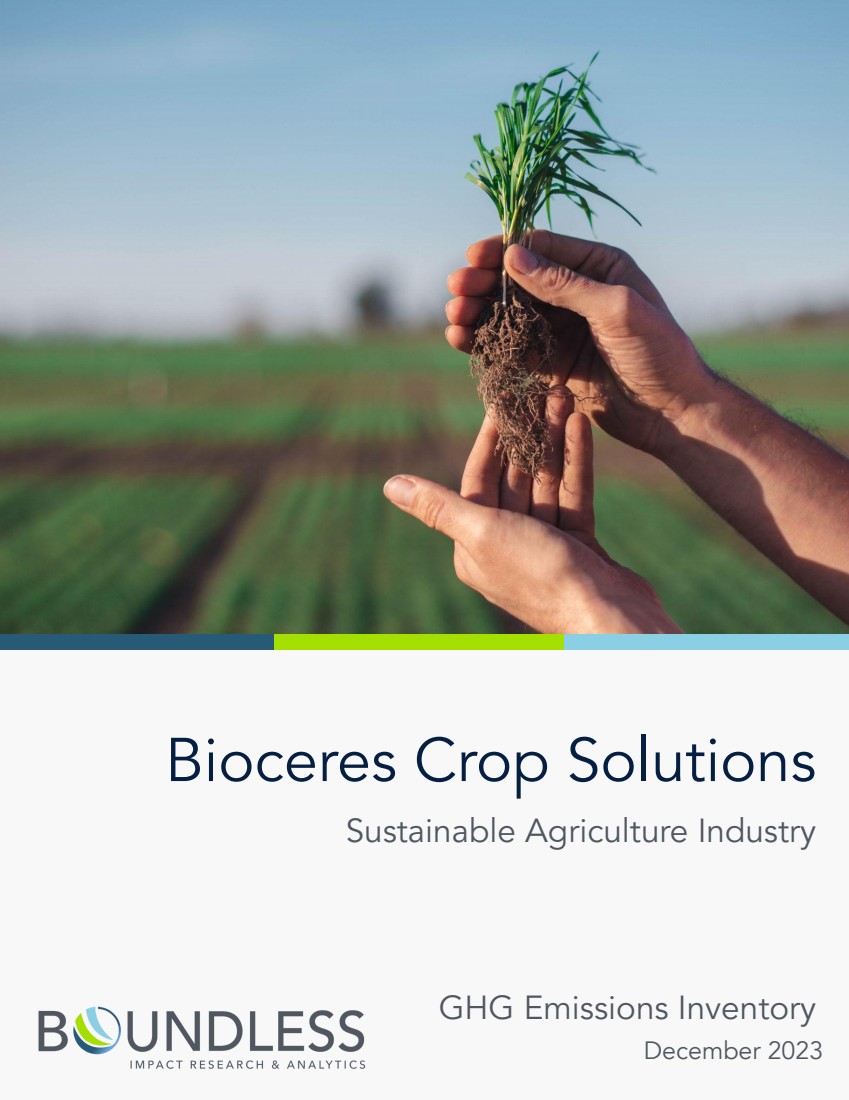
| Bioceres Crop Solutions
Sustainable Agriculture Industry
GHG Emissions Inventory
December 2023 |
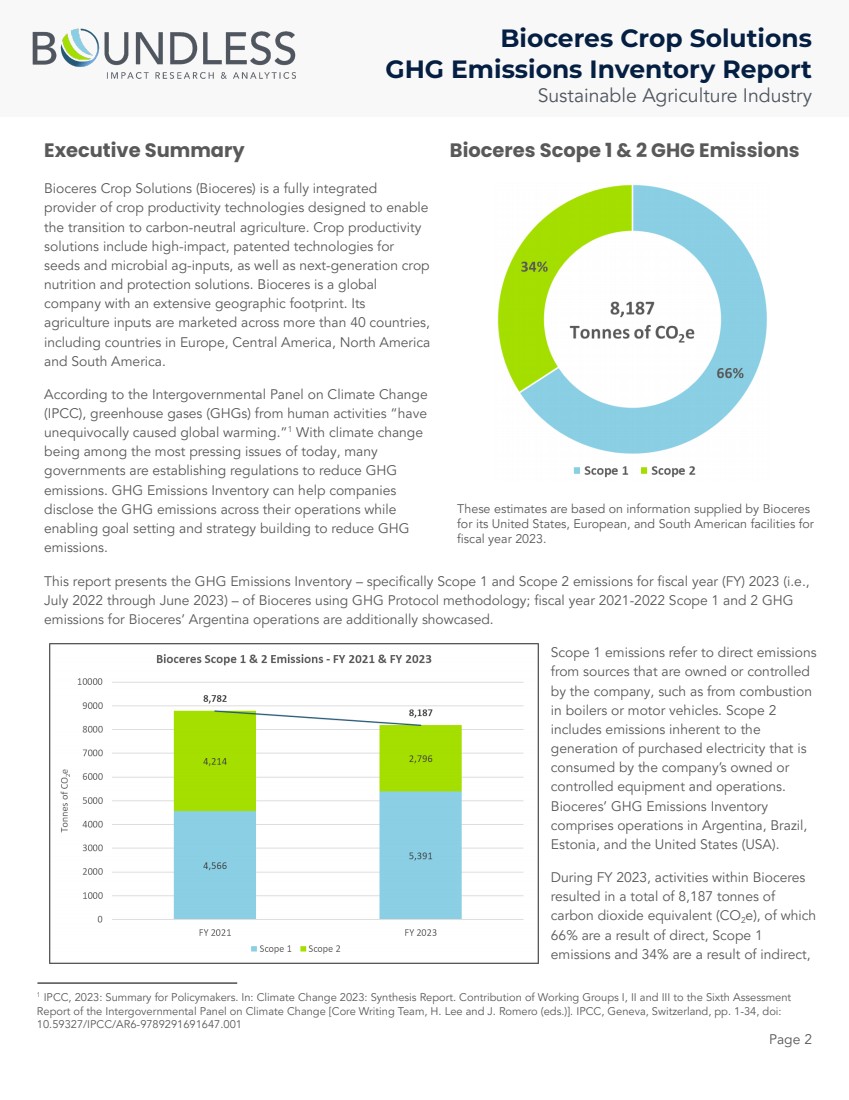
| Bioceres Crop Solutions
GHG Emissions Inventory Report
Sustainable Agriculture Industry
Executive Summary Bioceres Scope 1 & 2 GHG Emissions
Bioceres Crop Solutions (Bioceres) is a fully integrated
provider of crop productivity technologies designed to enable
the transition to carbon-neutral agriculture. Crop productivity
solutions include high-impact, patented technologies for
seeds and microbial ag-inputs, as well as next-generation crop
nutrition and protection solutions. Bioceres is a global
company with an extensive geographic footprint. Its
agriculture inputs are marketed across more than 40 countries,
including countries in Europe, Central America, North America
and South America.
According to the Intergovernmental Panel on Climate Change
(IPCC), greenhouse gases (GHGs) from human activities “have
unequivocally caused global warming.”
1 With climate change
being among the most pressing issues of today, many
governments are establishing regulations to reduce GHG
emissions. GHG Emissions Inventory can help companies
disclose the GHG emissions across their operations while
enabling goal setting and strategy building to reduce GHG
emissions.
These estimates are based on information supplied by Bioceres
for its United States, European, and South American facilities for
fiscal year 2023.
This report presents the GHG Emissions Inventory – specifically Scope 1 and Scope 2 emissions for fiscal year (FY) 2023 (i.e.,
July 2022 through June 2023) – of Bioceres using GHG Protocol methodology; fiscal year 2021-2022 Scope 1 and 2 GHG
emissions for Bioceres’ Argentina operations are additionally showcased.
Scope 1 emissions refer to direct emissions
from sources that are owned or controlled
by the company, such as from combustion
in boilers or motor vehicles. Scope 2
includes emissions inherent to the
generation of purchased electricity that is
consumed by the company’s owned or
controlled equipment and operations.
Bioceres’ GHG Emissions Inventory
comprises operations in Argentina, Brazil,
Estonia, and the United States (USA).
During FY 2023, activities within Bioceres
resulted in a total of 8,187 tonnes of
carbon dioxide equivalent (CO2e), of which
66% are a result of direct, Scope 1
emissions and 34% are a result of indirect,
1
IPCC, 2023: Summary for Policymakers. In: Climate Change 2023: Synthesis Report. Contribution of Working Groups I, II and III to the Sixth Assessment
Report of the Intergovernmental Panel on Climate Change [Core Writing Team, H. Lee and J. Romero (eds.)]. IPCC, Geneva, Switzerland, pp. 1-34, doi:
10.59327/IPCC/AR6-9789291691647.001
Page 2 |
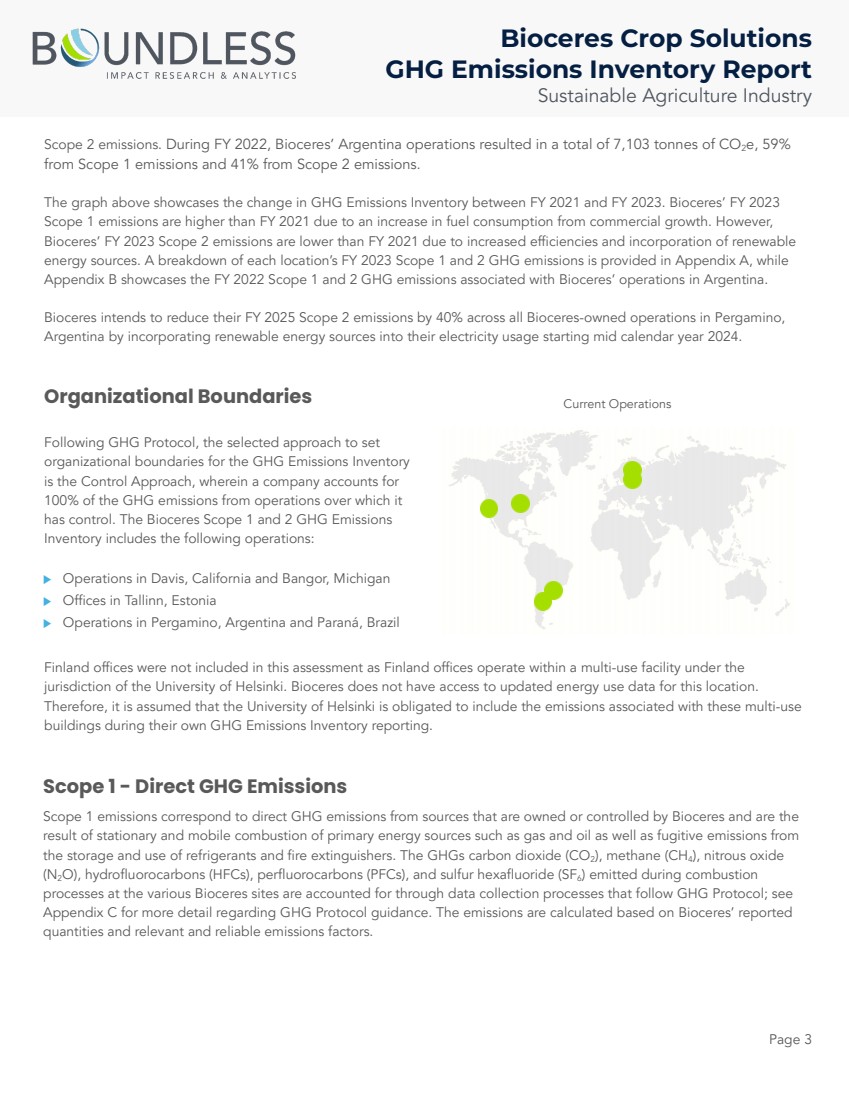
| Bioceres Crop Solutions
GHG Emissions Inventory Report
Sustainable Agriculture Industry
Scope 2 emissions. During FY 2022, Bioceres’ Argentina operations resulted in a total of 7,103 tonnes of CO2e, 59%
from Scope 1 emissions and 41% from Scope 2 emissions.
The graph above showcases the change in GHG Emissions Inventory between FY 2021 and FY 2023. Bioceres’ FY 2023
Scope 1 emissions are higher than FY 2021 due to an increase in fuel consumption from commercial growth. However,
Bioceres’ FY 2023 Scope 2 emissions are lower than FY 2021 due to increased efficiencies and incorporation of renewable
energy sources. A breakdown of each location’s FY 2023 Scope 1 and 2 GHG emissions is provided in Appendix A, while
Appendix B showcases the FY 2022 Scope 1 and 2 GHG emissions associated with Bioceres’ operations in Argentina.
Bioceres intends to reduce their FY 2025 Scope 2 emissions by 40% across all Bioceres-owned operations in Pergamino,
Argentina by incorporating renewable energy sources into their electricity usage starting mid calendar year 2024.
Organizational Boundaries Current Operations
Following GHG Protocol, the selected approach to set
organizational boundaries for the GHG Emissions Inventory
is the Control Approach, wherein a company accounts for
100% of the GHG emissions from operations over which it
has control. The Bioceres Scope 1 and 2 GHG Emissions
Inventory includes the following operations:
▶ Operations in Davis, California and Bangor, Michigan
▶ Offices in Tallinn, Estonia
▶ Operations in Pergamino, Argentina and Paraná, Brazil
Finland offices were not included in this assessment as Finland offices operate within a multi-use facility under the
jurisdiction of the University of Helsinki. Bioceres does not have access to updated energy use data for this location.
Therefore, it is assumed that the University of Helsinki is obligated to include the emissions associated with these multi-use
buildings during their own GHG Emissions Inventory reporting.
Scope 1 - Direct GHG Emissions
Scope 1 emissions correspond to direct GHG emissions from sources that are owned or controlled by Bioceres and are the
result of stationary and mobile combustion of primary energy sources such as gas and oil as well as fugitive emissions from
the storage and use of refrigerants and fire extinguishers. The GHGs carbon dioxide (CO2
), methane (CH4
), nitrous oxide
(N2O), hydrofluorocarbons (HFCs), perfluorocarbons (PFCs), and sulfur hexafluoride (SF6
) emitted during combustion
processes at the various Bioceres sites are accounted for through data collection processes that follow GHG Protocol; see
Appendix C for more detail regarding GHG Protocol guidance. The emissions are calculated based on Bioceres’ reported
quantities and relevant and reliable emissions factors.
Page 3 |
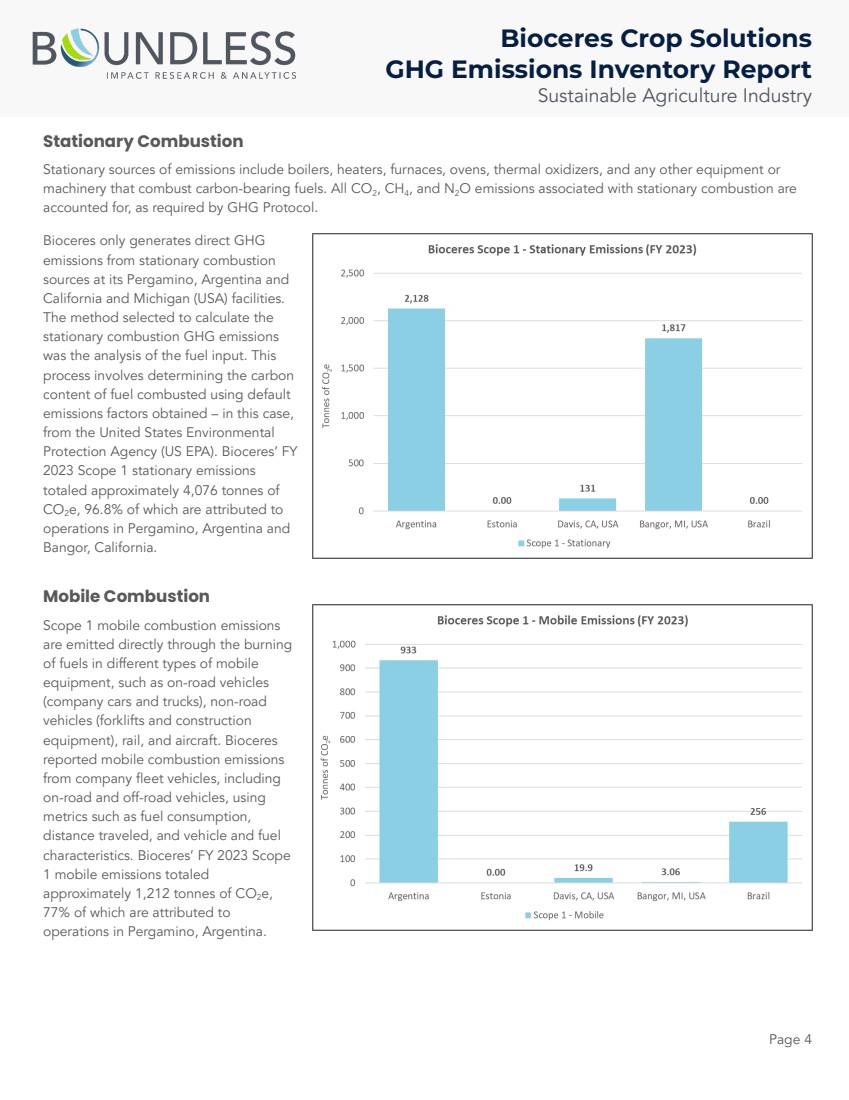
| Bioceres Crop Solutions
GHG Emissions Inventory Report
Sustainable Agriculture Industry
Stationary Combustion
Stationary sources of emissions include boilers, heaters, furnaces, ovens, thermal oxidizers, and any other equipment or
machinery that combust carbon-bearing fuels. All CO2
, CH4
, and N2O emissions associated with stationary combustion are
accounted for, as required by GHG Protocol.
Bioceres only generates direct GHG
emissions from stationary combustion
sources at its Pergamino, Argentina and
California and Michigan (USA) facilities.
The method selected to calculate the
stationary combustion GHG emissions
was the analysis of the fuel input. This
process involves determining the carbon
content of fuel combusted using default
emissions factors obtained – in this case,
from the United States Environmental
Protection Agency (US EPA). Bioceres’ FY
2023 Scope 1 stationary emissions
totaled approximately 4,076 tonnes of
CO2e, 96.8% of which are attributed to
operations in Pergamino, Argentina and
Bangor, California.
Mobile Combustion
Scope 1 mobile combustion emissions
are emitted directly through the burning
of fuels in different types of mobile
equipment, such as on-road vehicles
(company cars and trucks), non-road
vehicles (forklifts and construction
equipment), rail, and aircraft. Bioceres
reported mobile combustion emissions
from company fleet vehicles, including
on-road and off-road vehicles, using
metrics such as fuel consumption,
distance traveled, and vehicle and fuel
characteristics. Bioceres’ FY 2023 Scope
1 mobile emissions totaled
approximately 1,212 tonnes of CO2e,
77% of which are attributed to
operations in Pergamino, Argentina.
Page 4 |
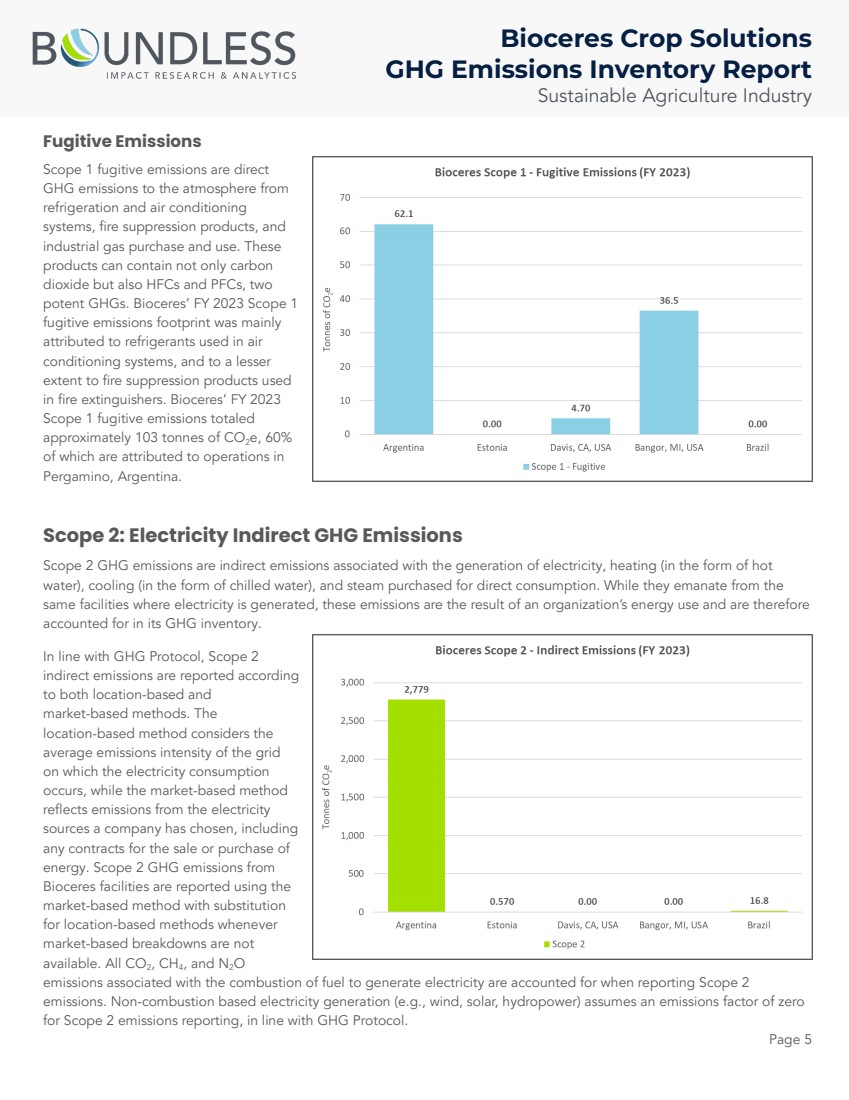
| Bioceres Crop Solutions
GHG Emissions Inventory Report
Sustainable Agriculture Industry
Fugitive Emissions
Scope 1 fugitive emissions are direct
GHG emissions to the atmosphere from
refrigeration and air conditioning
systems, fire suppression products, and
industrial gas purchase and use. These
products can contain not only carbon
dioxide but also HFCs and PFCs, two
potent GHGs. Bioceres’ FY 2023 Scope 1
fugitive emissions footprint was mainly
attributed to refrigerants used in air
conditioning systems, and to a lesser
extent to fire suppression products used
in fire extinguishers. Bioceres’ FY 2023
Scope 1 fugitive emissions totaled
approximately 103 tonnes of CO2e, 60%
of which are attributed to operations in
Pergamino, Argentina.
Scope 2: Electricity Indirect GHG Emissions
Scope 2 GHG emissions are indirect emissions associated with the generation of electricity, heating (in the form of hot
water), cooling (in the form of chilled water), and steam purchased for direct consumption. While they emanate from the
same facilities where electricity is generated, these emissions are the result of an organization’s energy use and are therefore
accounted for in its GHG inventory.
In line with GHG Protocol, Scope 2
indirect emissions are reported according
to both location-based and
market-based methods. The
location-based method considers the
average emissions intensity of the grid
on which the electricity consumption
occurs, while the market-based method
reflects emissions from the electricity
sources a company has chosen, including
any contracts for the sale or purchase of
energy. Scope 2 GHG emissions from
Bioceres facilities are reported using the
market-based method with substitution
for location-based methods whenever
market-based breakdowns are not
available. All CO2
, CH4
, and N2O
emissions associated with the combustion of fuel to generate electricity are accounted for when reporting Scope 2
emissions. Non-combustion based electricity generation (e.g., wind, solar, hydropower) assumes an emissions factor of zero
for Scope 2 emissions reporting, in line with GHG Protocol.
Page 5 |
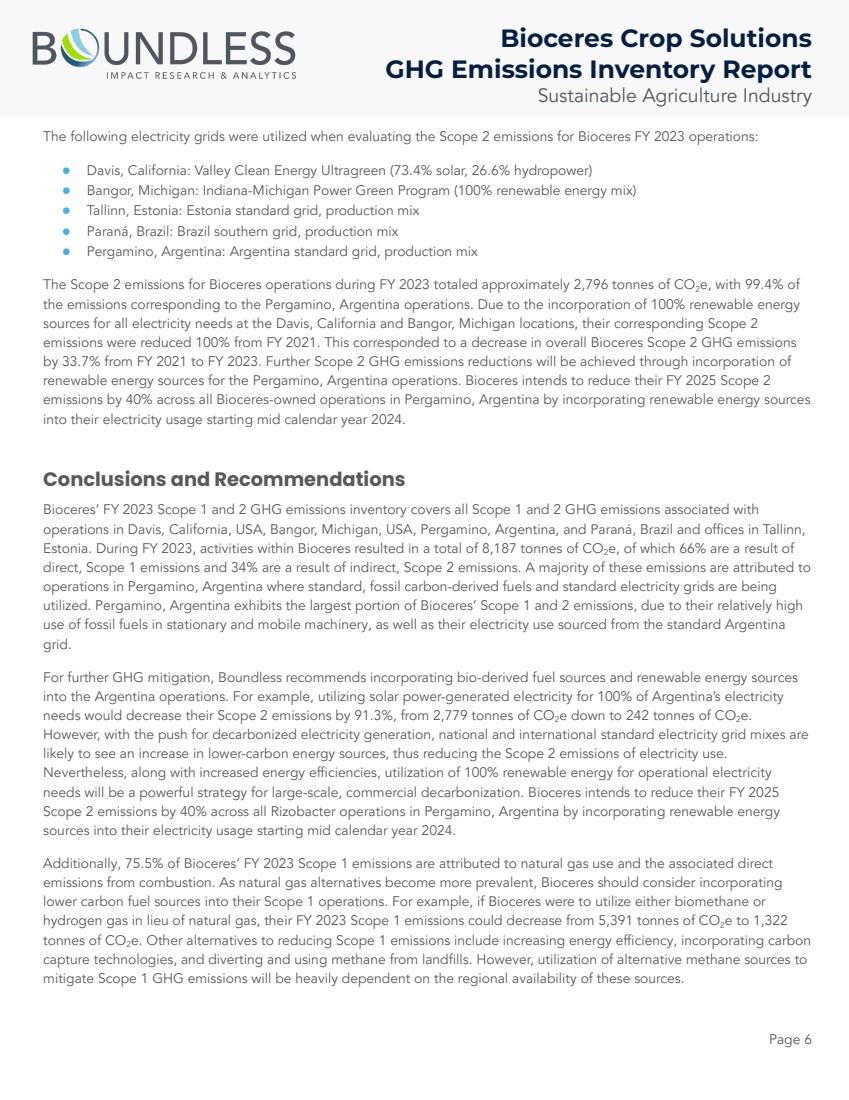
| Bioceres Crop Solutions
GHG Emissions Inventory Report
Sustainable Agriculture Industry
The following electricity grids were utilized when evaluating the Scope 2 emissions for Bioceres FY 2023 operations:
● Davis, California: Valley Clean Energy Ultragreen (73.4% solar, 26.6% hydropower)
● Bangor, Michigan: Indiana-Michigan Power Green Program (100% renewable energy mix)
● Tallinn, Estonia: Estonia standard grid, production mix
● Paraná, Brazil: Brazil southern grid, production mix
● Pergamino, Argentina: Argentina standard grid, production mix
The Scope 2 emissions for Bioceres operations during FY 2023 totaled approximately 2,796 tonnes of CO2e, with 99.4% of
the emissions corresponding to the Pergamino, Argentina operations. Due to the incorporation of 100% renewable energy
sources for all electricity needs at the Davis, California and Bangor, Michigan locations, their corresponding Scope 2
emissions were reduced 100% from FY 2021. This corresponded to a decrease in overall Bioceres Scope 2 GHG emissions
by 33.7% from FY 2021 to FY 2023. Further Scope 2 GHG emissions reductions will be achieved through incorporation of
renewable energy sources for the Pergamino, Argentina operations. Bioceres intends to reduce their FY 2025 Scope 2
emissions by 40% across all Bioceres-owned operations in Pergamino, Argentina by incorporating renewable energy sources
into their electricity usage starting mid calendar year 2024.
Conclusions and Recommendations
Bioceres’ FY 2023 Scope 1 and 2 GHG emissions inventory covers all Scope 1 and 2 GHG emissions associated with
operations in Davis, California, USA, Bangor, Michigan, USA, Pergamino, Argentina, and Paraná, Brazil and offices in Tallinn,
Estonia. During FY 2023, activities within Bioceres resulted in a total of 8,187 tonnes of CO2e, of which 66% are a result of
direct, Scope 1 emissions and 34% are a result of indirect, Scope 2 emissions. A majority of these emissions are attributed to
operations in Pergamino, Argentina where standard, fossil carbon-derived fuels and standard electricity grids are being
utilized. Pergamino, Argentina exhibits the largest portion of Bioceres’ Scope 1 and 2 emissions, due to their relatively high
use of fossil fuels in stationary and mobile machinery, as well as their electricity use sourced from the standard Argentina
grid.
For further GHG mitigation, Boundless recommends incorporating bio-derived fuel sources and renewable energy sources
into the Argentina operations. For example, utilizing solar power-generated electricity for 100% of Argentina’s electricity
needs would decrease their Scope 2 emissions by 91.3%, from 2,779 tonnes of CO2e down to 242 tonnes of CO2e.
However, with the push for decarbonized electricity generation, national and international standard electricity grid mixes are
likely to see an increase in lower-carbon energy sources, thus reducing the Scope 2 emissions of electricity use.
Nevertheless, along with increased energy efficiencies, utilization of 100% renewable energy for operational electricity
needs will be a powerful strategy for large-scale, commercial decarbonization. Bioceres intends to reduce their FY 2025
Scope 2 emissions by 40% across all Rizobacter operations in Pergamino, Argentina by incorporating renewable energy
sources into their electricity usage starting mid calendar year 2024.
Additionally, 75.5% of Bioceres’ FY 2023 Scope 1 emissions are attributed to natural gas use and the associated direct
emissions from combustion. As natural gas alternatives become more prevalent, Bioceres should consider incorporating
lower carbon fuel sources into their Scope 1 operations. For example, if Bioceres were to utilize either biomethane or
hydrogen gas in lieu of natural gas, their FY 2023 Scope 1 emissions could decrease from 5,391 tonnes of CO2e to 1,322
tonnes of CO2e. Other alternatives to reducing Scope 1 emissions include increasing energy efficiency, incorporating carbon
capture technologies, and diverting and using methane from landfills. However, utilization of alternative methane sources to
mitigate Scope 1 GHG emissions will be heavily dependent on the regional availability of these sources.
Page 6 |
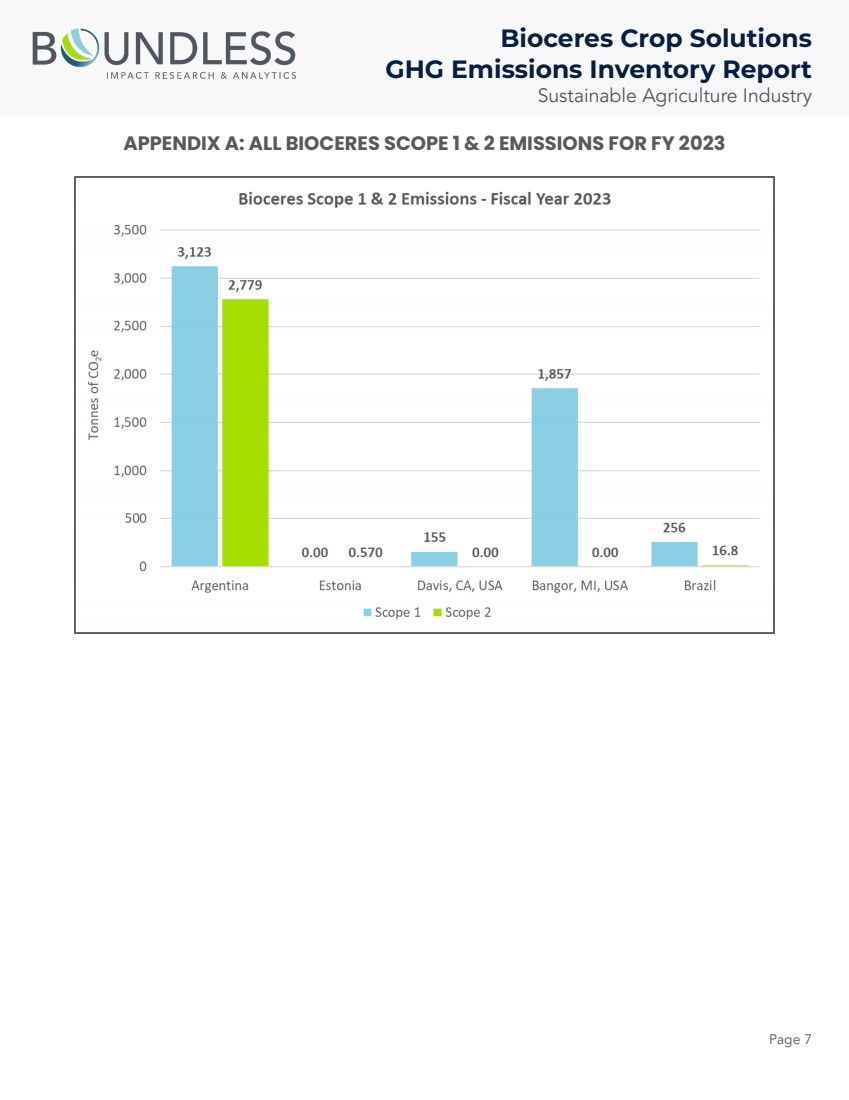
| Bioceres Crop Solutions
GHG Emissions Inventory Report
Sustainable Agriculture Industry
APPENDIX A: ALL BIOCERES SCOPE 1 & 2 EMISSIONS FOR FY 2023
Page 7 |
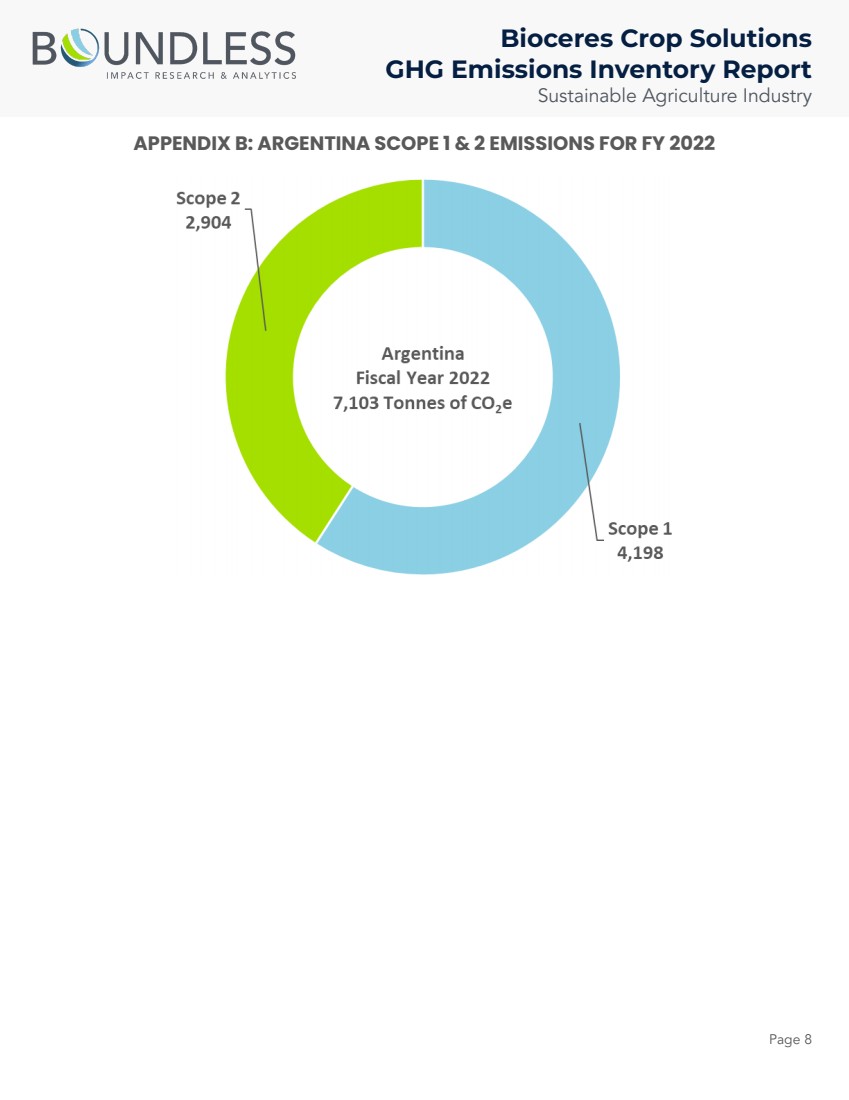
| Bioceres Crop Solutions
GHG Emissions Inventory Report
Sustainable Agriculture Industry
APPENDIX B: ARGENTINA SCOPE 1 & 2 EMISSIONS FOR FY 2022
Page 8 |
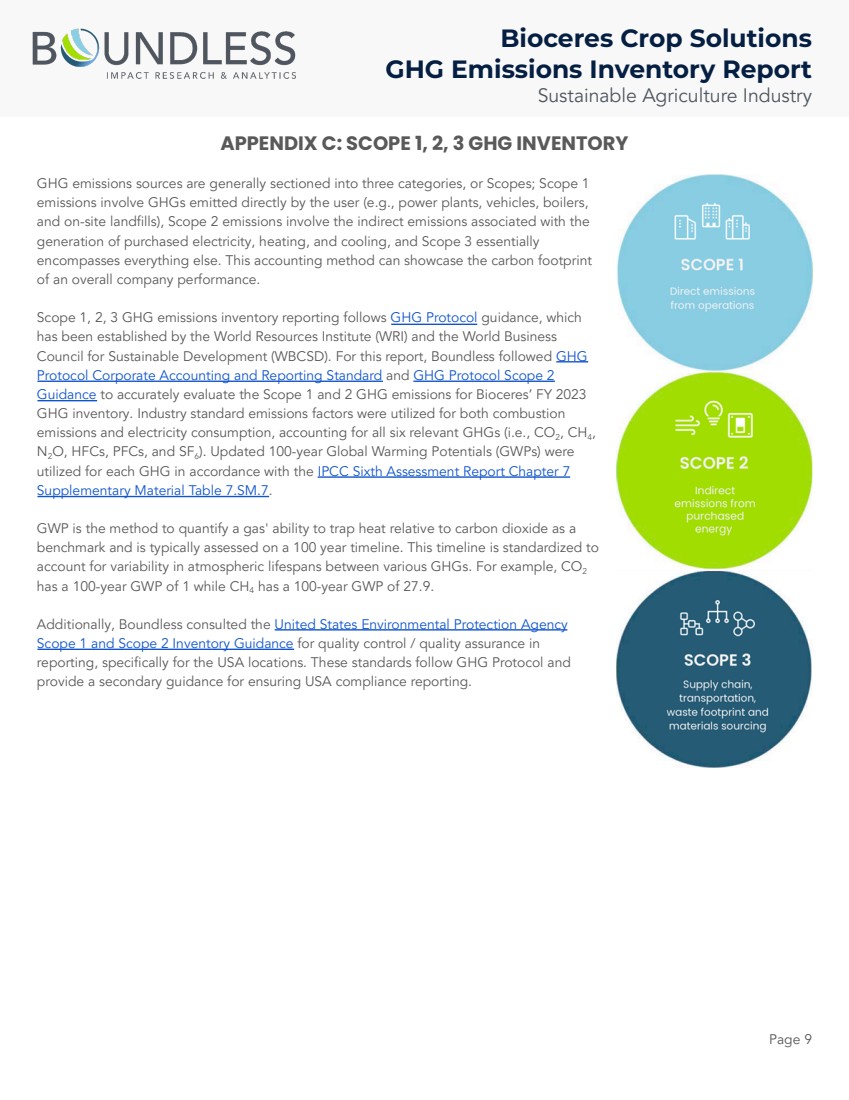
| Bioceres Crop Solutions
GHG Emissions Inventory Report
Sustainable Agriculture Industry
APPENDIX C: SCOPE 1, 2, 3 GHG INVENTORY
GHG emissions sources are generally sectioned into three categories, or Scopes; Scope 1
emissions involve GHGs emitted directly by the user (e.g., power plants, vehicles, boilers,
and on-site landfills), Scope 2 emissions involve the indirect emissions associated with the
generation of purchased electricity, heating, and cooling, and Scope 3 essentially
encompasses everything else. This accounting method can showcase the carbon footprint
of an overall company performance.
Scope 1, 2, 3 GHG emissions inventory reporting follows GHG Protocol guidance, which
has been established by the World Resources Institute (WRI) and the World Business
Council for Sustainable Development (WBCSD). For this report, Boundless followed GHG
Protocol Corporate Accounting and Reporting Standard and GHG Protocol Scope 2
Guidance to accurately evaluate the Scope 1 and 2 GHG emissions for Bioceres’ FY 2023
GHG inventory. Industry standard emissions factors were utilized for both combustion
emissions and electricity consumption, accounting for all six relevant GHGs (i.e., CO2
, CH4
,
N2O, HFCs, PFCs, and SF6
). Updated 100-year Global Warming Potentials (GWPs) were
utilized for each GHG in accordance with the IPCC Sixth Assessment Report Chapter 7
Supplementary Material Table 7.SM.7.
GWP is the method to quantify a gas' ability to trap heat relative to carbon dioxide as a
benchmark and is typically assessed on a 100 year timeline. This timeline is standardized to
account for variability in atmospheric lifespans between various GHGs. For example, CO2
has a 100-year GWP of 1 while CH4 has a 100-year GWP of 27.9.
Additionally, Boundless consulted the United States Environmental Protection Agency
Scope 1 and Scope 2 Inventory Guidance for quality control / quality assurance in
reporting, specifically for the USA locations. These standards follow GHG Protocol and
provide a secondary guidance for ensuring USA compliance reporting.
Page 9 |
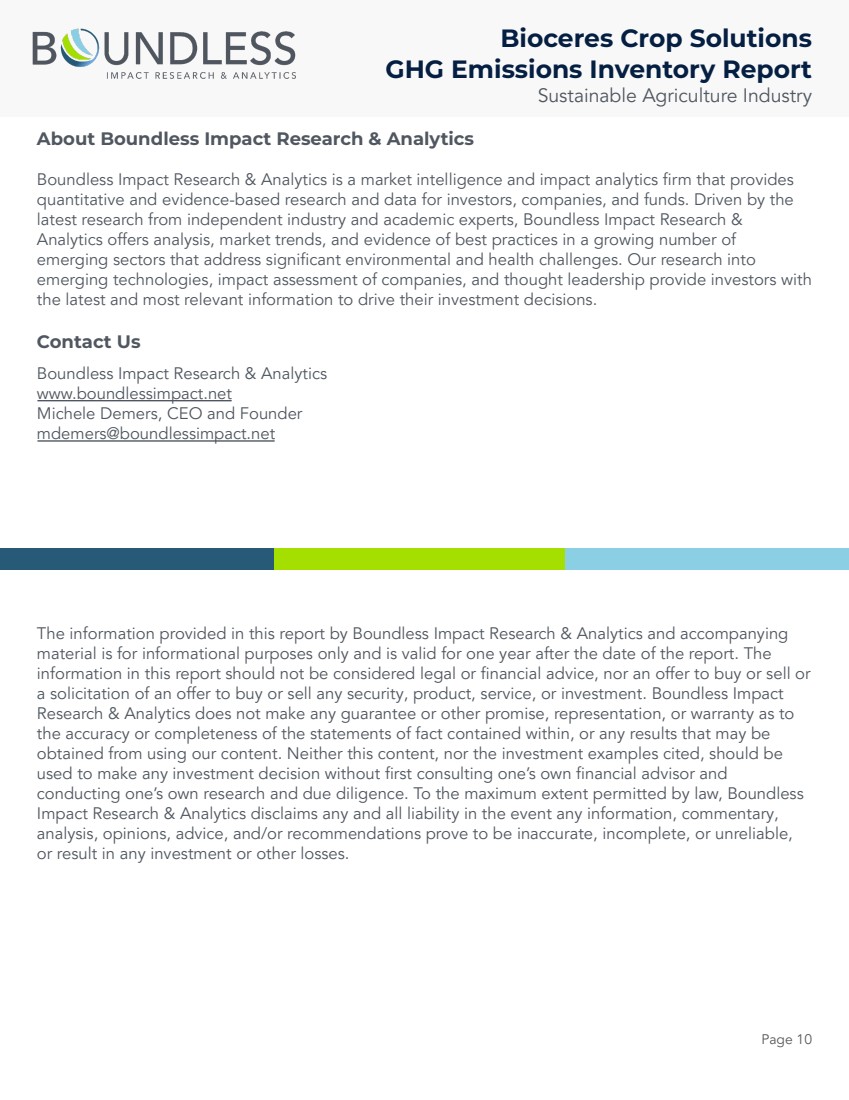
| Bioceres Crop Solutions
GHG Emissions Inventory Report
Sustainable Agriculture Industry
About Boundless Impact Research & Analytics
Boundless Impact Research & Analytics is a market intelligence and impact analytics firm that provides
quantitative and evidence-based research and data for investors, companies, and funds. Driven by the
latest research from independent industry and academic experts, Boundless Impact Research &
Analytics offers analysis, market trends, and evidence of best practices in a growing number of
emerging sectors that address significant environmental and health challenges. Our research into
emerging technologies, impact assessment of companies, and thought leadership provide investors with
the latest and most relevant information to drive their investment decisions.
Contact Us
Boundless Impact Research & Analytics
www.boundlessimpact.net
Michele Demers, CEO and Founder
mdemers@boundlessimpact.net
The information provided in this report by Boundless Impact Research & Analytics and accompanying
material is for informational purposes only and is valid for one year after the date of the report. The
information in this report should not be considered legal or financial advice, nor an offer to buy or sell or
a solicitation of an offer to buy or sell any security, product, service, or investment. Boundless Impact
Research & Analytics does not make any guarantee or other promise, representation, or warranty as to
the accuracy or completeness of the statements of fact contained within, or any results that may be
obtained from using our content. Neither this content, nor the investment examples cited, should be
used to make any investment decision without first consulting one’s own financial advisor and
conducting one’s own research and due diligence. To the maximum extent permitted by law, Boundless
Impact Research & Analytics disclaims any and all liability in the event any information, commentary,
analysis, opinions, advice, and/or recommendations prove to be inaccurate, incomplete, or unreliable,
or result in any investment or other losses.
Page 10 |
Bioceres Crop Solutions (NASDAQ:BIOX)
Historical Stock Chart
From Mar 2024 to Apr 2024
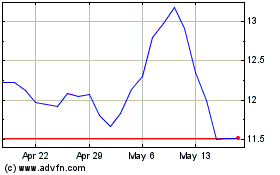
Bioceres Crop Solutions (NASDAQ:BIOX)
Historical Stock Chart
From Apr 2023 to Apr 2024
